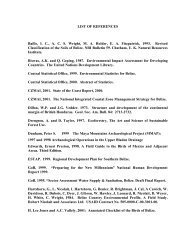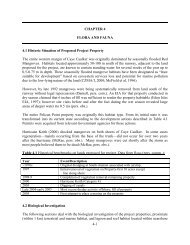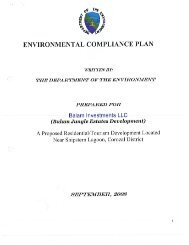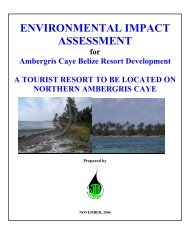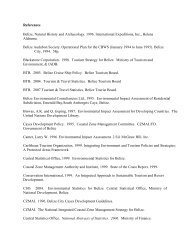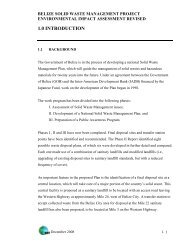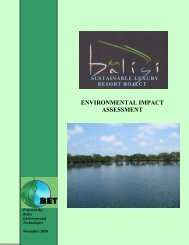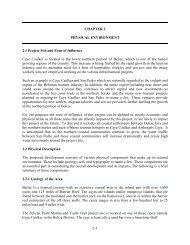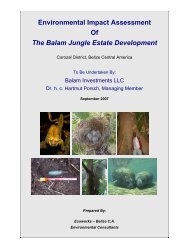Environmental Impact Assessment Of The Mountain Pine Ridge ...
Environmental Impact Assessment Of The Mountain Pine Ridge ...
Environmental Impact Assessment Of The Mountain Pine Ridge ...
Create successful ePaper yourself
Turn your PDF publications into a flip-book with our unique Google optimized e-Paper software.
Tectonics<br />
<strong>The</strong> granite batholith on which the mining site is located consists of an uplifted fault block of precretaceous<br />
basement, consisting of a synclinorium trending east-northeast and plunging to the west<br />
about 10 degrees (Bateson & Hall, 1977). <strong>The</strong> site lies some 5 Km southeast of the still-active<br />
Northern Boundary Fault, and is divided to the east by the 6-kilometer deep Cooma-Cairn dip-slip<br />
fault; to the north and south by at least two large perpendicular faults (the latter three most likely<br />
originating in the Paleozoic); and thereafter by numerous lesser faults and joints (of unknown, but<br />
probably more recent age). Displacements of some faults are shown by offset quartz veins, which<br />
indicate the area to have been tectonically affected after vein formation (Holland, 2002). <strong>The</strong> larger<br />
fault systems along with two earthquake epicenters recorded between 1900 and 1999 lying<br />
approximately 6 – 8 kilometers southwest and northwest (respectively) from the mining site were<br />
mapped by Cornic (2003).<br />
Illustration 19 shows the mining site itself to be positioned centrally among the latter three larger<br />
above-referenced faults, at approximately 2.5 Km distance. <strong>The</strong> coarse grained granite of the<br />
<strong>Mountain</strong> <strong>Pine</strong> <strong>Ridge</strong> exhibits microfractures and fault displacements that are likely the result of the<br />
granites position within a zone of abundant faulting, but mineral alteration within the infilled<br />
microfractures were taken by Dawe (1984) to be indicative of hydrothermal alteration. Inspections<br />
by other researchers (e.g. Holland 2002) indicate some fractures intermittently to be infilled with<br />
quartz at intervals ranging from a few centimeters to more than a meter, which also governs<br />
material suitability for mining and processing into finished products.<br />
Dawe (1984) and later Kwon (2005) surmised<br />
the mining site were probably tectonic valleys<br />
(owing to their alignments), comprised of<br />
structural joints, fractures or dislocation zones<br />
that have been secondarily influenced by<br />
groundwater weathering along the granite<br />
surface, causing soils and overburden to deepen<br />
on side slopes (see Illustration 20), and area<br />
creek flows to persist throughout the dry season<br />
that creek alignments immediately adjacent to.<br />
Stratigraphy<br />
Soil Structure & Classification<br />
ILLUSTRATION 20: GROUNDWATER FLOW &<br />
WEATHERING ALONG SIDESLOPES<br />
King et al 1992 report the soils of the project site to largely consist of Stopper suite Pinol subsuite<br />
soils, which consist of the colluvial and hillwash soils formed on the granites off the <strong>Mountain</strong> <strong>Pine</strong><br />
<strong>Ridge</strong>. King et al further report there is considerable variation in the Pinol subsuite, with the main<br />
soils of slopes on the more melanocratic granites characterized by bright red and yellow colors and<br />
moderate depth with a very diffuse gradation to the underlying weathering granite; and the topsoil of<br />
stable sites being either shallow and moderately dark, or lacking melanized topsoil altogether (see<br />
Illustration 21: Upper left photo: deeper soils of the side slope at the mining site; Upper right photo:<br />
shallow soil of the top slope at the mining site).<br />
<strong>The</strong> <strong>Mountain</strong> <strong>Pine</strong> <strong>Ridge</strong> Granite Quarry EIA / Ecoworks Page 36 of 167




